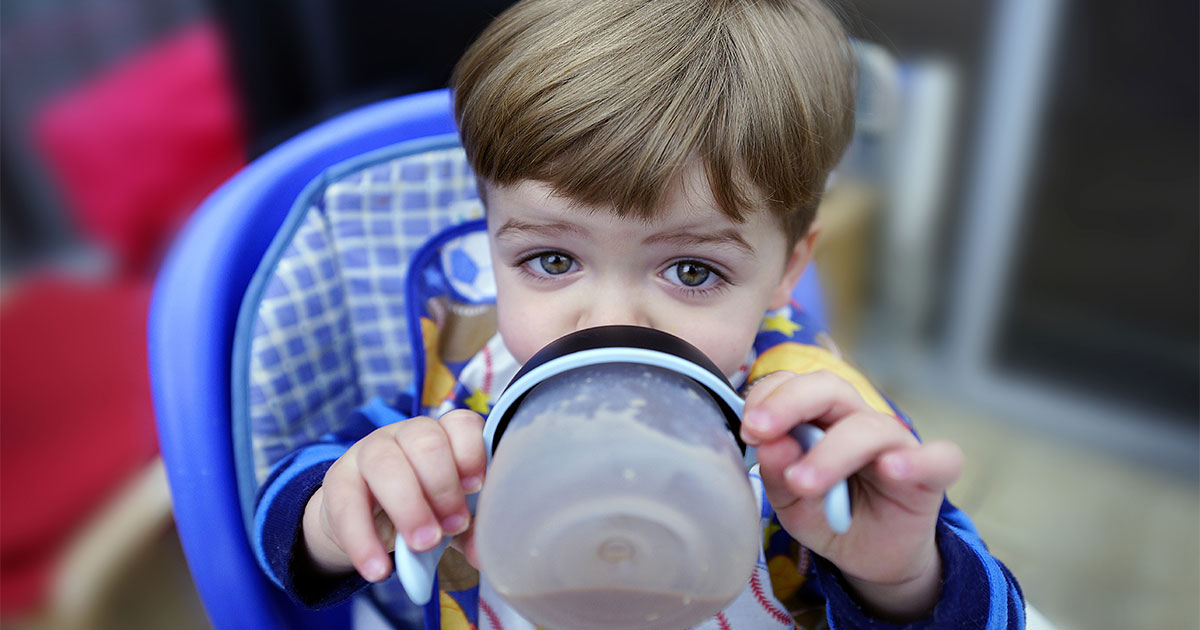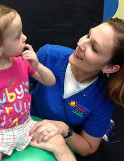

When should parents start thinking about introducing a sippy cup?
Ahhh, the great sippy cup debate. What, you didn’t realize that sippy cups are controversial? Well actually, they are! And what makes this even more tricky is that each slightly conflicting view has very real and valid arguments. So, to help tease out the pros and cons of sippy cup use, I sought the advice of fellow speech-language pathologists here at Children’s Therapy TEAM, Dr. Karen Green, DDS from Pediatric Dental Associates in Fayetteville, Arkansas, and online with the American Academy of Pediatrics.
Pediatric Dentist Perspective (Dr. Karen Green, DDS)
The American Academy of Pediatric Dentistry recommends transitioning away from the bottle/breast when the infant is 1 year old. The reason behind this is that the child can develop severe early childhood caries (formerly known as baby bottle tooth decay). A child who nurses on demand or is allowed to carry a cup of milk/formula around to suck on throughout the day is much more likely to develop these cavities. Milk (breast, cow, or soy) contains sugars. These are fermentable carbohydrates that are digested by oral bacteria into acids that can lead to enamel breakdown and eventually cavities. In addition, if the child uses the sippy cup like a pacifier, it can lead to tipping of the teeth (teeth shifting forward or backward).
Sippy cups are great for learning to transition to a cup, but their use should be limited to the learning period. Once the child has the ability to use an open cup, the sippy cup should be discontinued. A cup with a lid and a straw is a good option to keep sugary liquids off of the top front teeth, but note that these liquids will still remain on the back teeth. I don’t see any reason straws should be discouraged, unless the child develops a bad habit of chewing on the straws. In addition, juice should be limited to no more than 4-6 ounces per day. Only allow milk or juice in the cup/sippy cup at mealtimes.
Between meals, only water should be given, and NEVER put your child to bed with milk or juice. I would also advice against giving sodas/sweet tea to children in general as this is added and unnecessary sugar that can be avoided, and it should definitely never be put in a sippy cup or bottle.
Pediatric Physician Perspective (American Academy of Pediatrics)
The American Academy of Pediatrics recommends breastfeeding as the sole source of nutrition for your baby in the first 6 months. Once solid foods are introduced, it is recommended to continue breastfeeding until at least 12 months. Breastfeeding can continue after 12 months if both the mother and the baby desire. For those infants that are bottle-fed, the recommendation is that bottles should be phased out between 12-24 months of age. When weaning from either breastfeeding or bottle, the AAP recommends using a sippy cup to transition. This transition to an open cup should occur as quickly as possible, preferably before 2 years of age. The AAP also cautions against “grazing” on milk, juice, sodas, or any beverages other than water, as it can lead to tooth decay.
Pediatric Speech-Language Pathologist Perspective (Connie Clark, CCC-SLP and Amy Love-Smith, CCC-SLP)
We agree that infants should be weaned from the bottle/breast at around 1 year of age, but not necessarily to a sippy cup. Quite frankly, sippy cups are simply a tool to keep kitchen floors clean from spilled milk rather than a necessary developmental milestone. We feel that around 12 months of age, a child would preferably be transitioned from the bottle/breast to a cup with a straw or an open cup. A cup with a straw promotes more mature lip closure and tongue retraction, whereas a sippy cup continues to promote the immature sucking pattern associated with a bottle.
We also agree that cups should primarily contain water between meals with milk being reserved for meal-times. Drinking milk and juice between meals leads children to fill their caloric intake with liquids; therefore, they are not hungry for actual food at mealtimes. This can cause food battles and “picky eating” that would not normally be an issue for many children.
Pediatric Occupational Therapist Perspective (Melissa Foster, OTR/L)
I have a slightly different slant on the whole sippy cup issue. Personally, I like to introduce sippy cups a bit earlier, at around 6 months of age. In my practice (primarily with children with Sensory Processing Disorder), I find that many children become dependent on drinking from only a bottle or nursing from the breast, and are resistant to the change of drinking from a cup. The closer the child gets to 12 months, the more stubborn he can be! SO, whether it is from a sippy cup, open cup, straw cup, or simply taking sips from a straw held from Mom’s glass of ice water, I prefer for infants to begin being exposed to different vessels early.
Now, I realize that this is earlier than others recommend. This is why I think it is perfectly fine to put formula or expressed breast milk in these various containers for purely experimentation sake so that the infant can learn that nutrition can come from many different sources. Furthermore, in keeping with the sentiment of dentists, physicians, and speech-language pathologists, I agree that milk, juice, etc. should be reserved for scheduled meal/snack times. (And soda should NEVER be used in a sippy cup or bottle!) Water should be the only allowed drink between meals to prevent “grazing”. This creates the hunger drive necessary for the child to be a more adventurous and successful eater during mealtimes and will reduce the likelihood of the child becoming a “picky eater”.
Conclusion
As I warned, the recommendations differ slightly as to when to wean, and what the recommended next step is. In studying the literature carefully, it seems that the only consensus is to stick with milk and water, and eliminate or significantly reduce any other beverages. As with all things in life, I really think this is a time to know your child, know your family, and know what your concerns are for your particular child. In my opinion, the bottom line is do what you can to try to minimize cavities and to use the sippy cup only as a short-term transition tool geared towards teaching the child how to drink from a ‘standard’ cup.
About the author
Melissa Foster is a Nationally Board Certified Occupational  Therapist who received her Masters in Occupational Therapy from University of Central Arkansas in 2004. She came to TEAM in 2013 with a wealth of treatment experience in settings that range from NWA to Kansas to New York. Her primary interests are treatment of children on the Autism Spectrum, treatment of children with ADHD and treatment of children with sensory processing and behavioral disorders. Melissa is an active public speaker in the NWA community on topics related to Autism and Sensory Processing Disorder. She has authored several resource materials for parents on topics such as sleep and picky eating. Her blog for parents addresses a new topic every Monday and has become a popular resource for families. Melissa loves spending time with her husband and their two children. On warm summer days she enjoys sitting on her patio with a good book and a glass of iced tea.
Therapist who received her Masters in Occupational Therapy from University of Central Arkansas in 2004. She came to TEAM in 2013 with a wealth of treatment experience in settings that range from NWA to Kansas to New York. Her primary interests are treatment of children on the Autism Spectrum, treatment of children with ADHD and treatment of children with sensory processing and behavioral disorders. Melissa is an active public speaker in the NWA community on topics related to Autism and Sensory Processing Disorder. She has authored several resource materials for parents on topics such as sleep and picky eating. Her blog for parents addresses a new topic every Monday and has become a popular resource for families. Melissa loves spending time with her husband and their two children. On warm summer days she enjoys sitting on her patio with a good book and a glass of iced tea.
Resources (Accessed May 2019)
Pediatric Dental Associates, Fayetteville, AR
What to Expect: Introducing a Sippy Cup From baby bottle to cup: Choose training cups carefully and use them temporarily, American Dental Association
Get It Done in Year One, American Academy of Pediatric Dentistry
Weaning Your Baby, American Academy of Pediatrics
AAP Reaffirms Breastfeeding Guidelines, American Academy of Pediatrics Discontinuing the Bottle, American Academy of Pediatrics
What Kids Should Drink. Melissa Foster, Children’s Therapy TEAM Blog
last update May, 2019.
